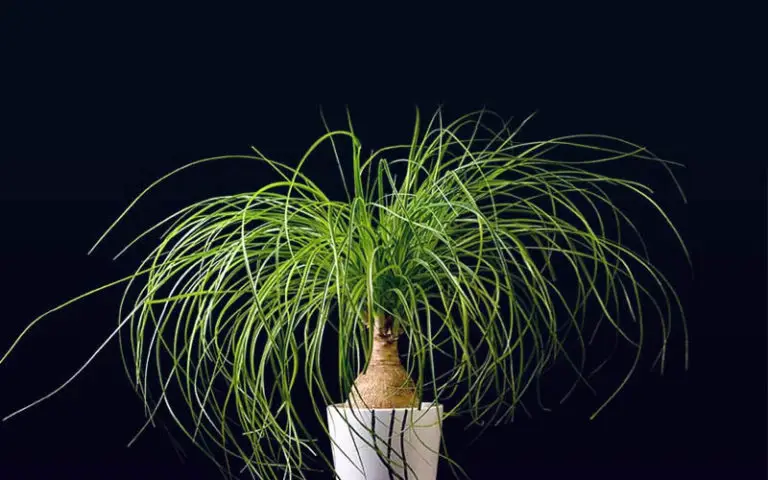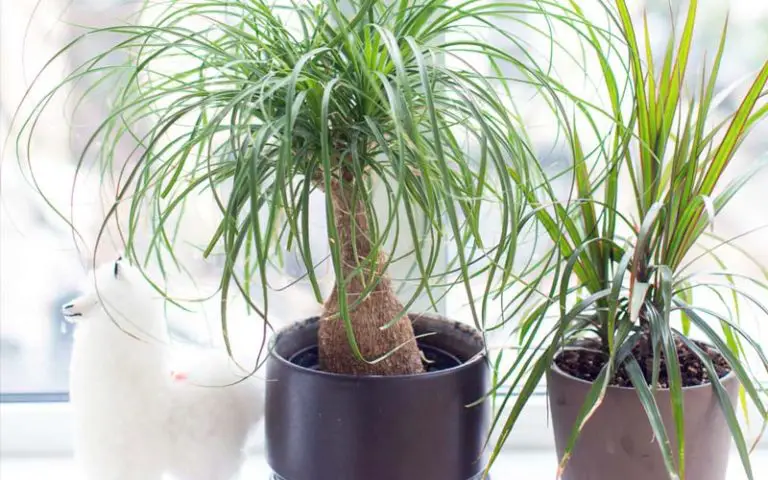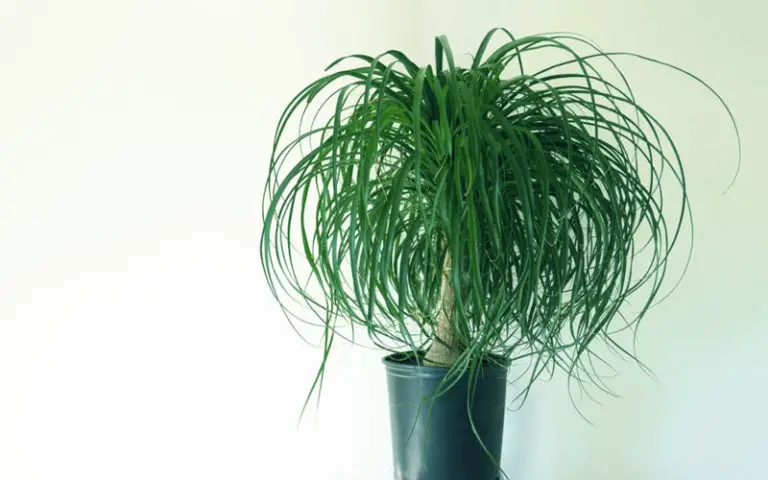Ponytail Palm Bonsai Fact Sheet

Beaucarnea Recurvata
The Ponytail Palm makes for a very interesting bonsai. While not a palm but rather part of the lily family, the Ponytail Palm has a unique bulbous trunk. It is from this trunk that it received its other name of Elephant’s Foot.
The bulbous trunk and the texture of the mature trunk resembles an elephant’s foot. This tree is a hardy tree that is very drought resistant thanks to storing water in its trunk. It also does great as an indoor bonsai. These factors make it an excellent addition to any bonsai collection or even for beginners to start with.
Here’s what you’ll find in our Ponytail Palm bonsai species guide:
Here’s what you’ll find in our Ponytail Palm bonsai species guide:
01
02
03
04
05
06
Quick Ponytail Palm Bonsai Care Sheet
We will be covering the different aspects of caring for a Ponytail Palm in more detail in the sections to follow. For quick reference, we will summarize the information below.
Recommended soil
A fast draining, sandy soil.
Watering
Only water once the soil is no longer damp. This can take up to two weeks during wetter seasons. Remember the bulbous trunk stores water like a reservoir.
Potting season
Mid-summer, every four to five years.
Shaping and pruning season
Can be done throughout the year.
Light
Indirect or direct sunlight. Can be kept indoors.
Fertilizing
Spring/Summer: Every two weeks.
Autumn/Winter: Once a month
Do not fertilize for three to four weeks after repotting.
Propagation methods
Seeds and cuttings (rarely).
Pests and diseases
Spider mites, scale and root rot.
Growth patterns
Slow grower with a thick bulbous trunk and long strap like leaves that droop down gracefully.
Recommended styles
Formal upright (chokkan) or Twin trunk (Sokan).
Native area
Southeast Mexico.
Scientific Classification
- Division: Angiosperms
- Class: Monocots
- Order: Asparagales
- Family: Arecaceae
- Genus: Beaucarnea
- Species: Beaucarnea Recurvata

How to Care for a Ponytail Palm Bonsai
Although this bonsai is a very hardy and forgiving bonsai, there are a few considerations that must be kept to keep your tree thriving. Let’s look at the different aspects you need to look after to ensure a healthy bonsai.
Best Soil
Ponytail Palms grow best in very sandy soil that drains thoroughly. As this tree originates from the warm and dry areas of the Mexico desert, these trees are uniquely suited to the dry, sandy soil. A good mix that has seen these bonsai thriving is one part potting soil to one part sand to one part perlite. Alternatively, you can also use cacti or succulent potting mix.
Ponytail Palms require a neutral ph between 6.5 and 7.5 for ideal growth and tree health.
Watering
Ponytail Palms require much less watering than a lot of other bonsai. They are acclimated to drier areas and have adapted to store water in the base of their trunk. It is this water reserve that gives the tree its unique bulbous trunk. As such, they are extremely drought resistant and can last for two to four weeks without water, although we would not advise that.
A good guide is to ensure that you water the bonsai once the soil appears dry, but do not wait for the soil to dry out too much. This can sometimes take about two weeks in cooler and wetter seasons. If you are unsure about your tree’s watering needs, you can use a water meter until you’re familiar with your tree’s needs.
Repotting
Repotting of this bonsai should be done in the middle of summer as that is when the tree will be at the top of its health and recover quickly. Since the Ponytail Palm is a tropical species, it can go for between four and five years between repotting. The Ponytail Palm is also one of the few species that prefers to be slightly root bound, which is another reason it can go for longer without being repotted.
Be mindful of the size of your pot when repotting your Ponytail Palm. Repotting into a bigger pot will allow your tree to become taller. However, if kept in the same size pot, the tree might not grow in height, but the trunk will become thicker.
When pruning the roots during repotting, never remove more than one-fourth of the total roots. Also, these bonsai do best in ceramic or clay pots as their roots have been known to burst out of plastic pots.
Shaping and Pruning
The Ponytail Palm does not require too much training and also cannot be wired. As such, using a clip and grow technique when you want to change the look of your tree will be your best option. However, these trees do well and look good with just a bit of regular pruning. And trimming.
Trimming the leaves will be enough to keep your tree looking fresh and healthy. When pruning new growth, never remove all of the new development as that can be detrimental to the overall health of your tree.
Location and Sunlight
The Ponytail Palm can do well as an indoor bonsai and require a bright space in direct or partial sunlight. Keep them in warmer areas, especially when the winter hits. Keeping your bonsai on a windowsill in winter when it gets very cold can be detrimental to the tree’s health as they prefer warmer areas.
Outdoor, these trees do well in partial or full sun. They can also handle some wind, especially if the tree is older. It is recommended to move the bonsai indoors when temperatures drop below 50 degrees Fahrenheit. This can be in a greenhouse, conservatory or south-facing windowsill.
Fertilizing
Fertilizing your bonsai is essential to its health. This is because so many of the nutrients are washed away during each watering. You can apply a liquid fertilizer once every two weeks during the growing season and only once a month during winter for your Ponytail Palm bonsai. If you prefer using slow-release fertilizer pellets, you can replenish them once every two months.
It is important to remember that you shouldn’t fertilize your bonsai three to four weeks after repotting. It is also essential that your tree is well watered before you apply the fertilizer.
Propagation Methods
The easiest way to propagate Ponytail Palms is to grow them from seeds. Place seeds between two layers of kitchen towel. Spray the towels until they are damp and keep them in a cool, dry place out of the wind and direct sunlight until the seeds sprout. It can take up to two weeks for the seeds to germinate if all conditions are met. Once sprouted, the seedlings can carefully be planted into a seedling tray, where they can be left until they reach a height of two inches.
There may be times when your Ponytail Palm will produce an offset from the base of the tree. This offset can be carefully removed and then dipped in rooting powder and grown as a cutting. This does not always happen and is not the easiest way to propagate from a cutting, although it is possible in some cases.
Pests and Diseases
The Ponytail Palm is susceptible to spider mites and scale. However, this is easy enough to treat if you are vigilant. You can use an organic pesticide spray to get rid of these pests. Alternatively, you can also use a neem oil and water spray or add a tablespoon of dish soap to your water and spray with that to remove the insects.
Another threat to this bonsai is root rot, which is caused by overwatering. This is why it is critical to ensure that you use soil with good drainage and not over-water your tree.
Growth Patterns
The Ponytail Palm is a slow-growing tree. The base usually grows up straight with long strap-like leaves sprouting from the top and cascading gracefully down. Leaves can be trimmed shorter without causing too much damage to the tree. New growth will appear during the growing season, and although some of the new growth can be removed, you should never remove all the new growth.
Recommended Styles
The best and most natural style for a Ponytail Palm is the formal upright (chokkan) style, as this is how they are most often found in nature. Another style that can be very becoming is the twin trunk (shokan) style. This bonsai cannot be wired, so you will need to use the clip and grow method if you want to train your bonsai.

Considerations for Growing an Indoor Ponytail Palm
Ponytail Palms are outstanding indoor bonsai that can flourish in homes and even offices. They do not require too much specific care, making them ideal for new or experienced bonsai keepers.
Great as an Indoor Bonsai
They do not require too much to thrive. They need little watering and a warm, dry space, indirect or shaded light. They have a very interesting look which also makes them a beautiful feature in your home or office.
Do Not Over Water
Do not water this bonsai every day, as this could lead to root rot. Instead, just check that the soil is damp, and once it starts feeling dry, you can water. This can mean that there can be about two weeks between waterings.
Keep Away from Windows in Winter
The bonsai are not fond of very cold weather as they are used to hot and dry climates. When it gets frigid in winter, move your bonsai away from the window as this can cause frost damage to your tree.
Common Issues When Caring For a Ponytail Palm Bonsai
The Ponytail Palm, as mentioned, is a hardy tree, and that also translates to common issues. The most common problem with this tree is overwatering, which could lead to root rot. There are the occasional pests that can be treated with a pesticide. However, if you monitor your watering and don’t water too often and check for pests regularly, there is no reason why your bonsai shouldn’t be healthy and thriving.
Interesting Facts About Ponytail Palm Bonsai
The Ponytail Palm is a fascinating species, especially when it comes to the art of bonsai. Let’s look at some of the most exciting things about this particular tree.
- The Ponytail Palm, despite its name, is not a palm but rather part of the lily family.
- The Ponytail Palm can reach an astonishing age of 250-350 years old.
- The Ponytail Palm stores water in its thick bulbous trunk and can go without water for up to four weeks.

FAQs about Ponytail Palm Bonsai
We have also provided a list of questions we have been asked and provide you with the answers. If you have any questions that haven’t been addressed in this fact sheet, please contact us.
A Ponytail Palm can make an exciting bonsai with its thick, textured trunk. By trimming back the leaves that sprout from the top, you can force the leaves to grow from the sides and droop gracefully down to make a stunning bonsai. This bonsai can be trimmed slightly throughout the year to maintain the bonsai look.
You can spray your bonsai once a week with a light misting of water to remove dust and other particles that accumulate on the leaves.
Approximately every seven to 10 days, once the soil is no longer moist. It should also be noted that it can take up to two weeks for the soil to dry out before being watered.
Ponytail Palms don’t usually bloom until they are at least ten years old, and it could sometimes take up to thirty years before you see any blooms. Blooms typically appear from the top of the tree in the summer months.







